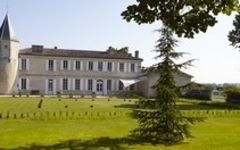Chateau Corbin 2019
-
James
Suckling -
Jeb
Dunnuck -
Robert
Parker -
Wine
Enthusiast



Product Details
Your Rating
Somm Note
Winemaker Notes
Blend: 90% Merlot, 10% Cabernet Franc
The Barrel Sample for this wine is above 14% ABV.
Professional Ratings
-
James Suckling
Aromas of ripe dark and blue fruit with hints of chocolate, licorice and wet earth. It has full body and a firm tannin structure. Chewy and compact. Juicy fruit and hints of crushed stones on the finish. Merlot, cabernet franc and cabernet sauvignon.
-
Jeb Dunnuck
The 2019 Château Corbin is a complex, medium to full-bodied effort with the spicy red and black fruit character of the vintage as well as notes of dried flowers, Asian spice, chocolate, and lead pencil. Wonderfully balanced, with ripe yet present tannins, a good sense of freshness, and a great finish, it's going to drink nicely for 15-20 years.
-
Robert Parker's Wine Advocate
Whether I landed on an off bottle or simply misunderstood the wine when I tasted it a few months ago is unclear, but what is certain is that I misjudged the 2019 Corbin. Offering up inviting aromas of plums, raspberries, violets, vine smoke and raw cocoa, it's medium to full-bodied, supple and enveloping, with velvety tannins, succulent acids and an elegant, complete profile. This beautiful wine includes some 15% Cabernet Franc.
-
Wine Enthusiast
Ripe fruit and juicy acidity have come together in this dense wine. The tannins and the weight are an important part of its make up, giving richness and ripe fruit flavors.
Barrel Sample: 90-92
Other Vintages
2022-
Robert
Parker -
James
Suckling -
Jeb
Dunnuck - Decanter
- Decanter
-
Jeb
Dunnuck -
Robert
Parker -
James
Suckling
- Vinous
-
James
Suckling - Decanter
-
Wilfred
Wong -
Jeb
Dunnuck -
Wine
Enthusiast - Decanter
-
Robert
Parker -
James
Suckling
-
Wine
Enthusiast -
Robert
Parker -
James
Suckling - Decanter
-
Wine
Spectator
-
Wine
Enthusiast -
Jeb
Dunnuck -
James
Suckling -
Robert
Parker -
Wine
Spectator - Decanter
-
James
Suckling -
Wine
Spectator
-
Robert
Parker -
James
Suckling
-
Wine
Spectator
-
Robert
Parker

One of the world’s most classic and popular styles of red wine, Bordeaux-inspired blends have spread from their homeland in France to nearly every corner of the New World. Typically based on either Cabernet Sauvignon or Merlot and supported by Cabernet Franc, Malbec and Petit Verdot, the best of these are densely hued, fragrant, full of fruit and boast a structure that begs for cellar time. Somm Secret—Blends from Bordeaux are generally earthier compared to those from the New World, which tend to be fruit-dominant.

Marked by its historic fortified village—perhaps the prettiest in all of Bordeaux, the St-Émilion appellation, along with its neighboring village of Pomerol, are leaders in quality on the Right Bank of Bordeaux. These Merlot-dominant red wines (complemented by various amounts of Cabernet Franc and/or Cabernet Sauvignon) remain some of the most admired and collected wines of the world.
St-Émilion has the longest history in wine production in Bordeaux—longer than the Left Bank—dating back to an 8th century monk named Saint Émilion who became a hermit in one of the many limestone caves scattered throughout the area.
Today St-Émilion is made up of hundreds of independent farmers dedicated to the same thing: growing Merlot and Cabernet Franc (and tiny amounts of Cabernet Sauvignon). While always roughly the same blend, the wines of St-Émilion vary considerably depending on the soil upon which they are grown—and the soils do vary considerably throughout the region.
The chateaux with the highest classification (Premier Grand Cru Classés) are on gravel-rich soils or steep, clay-limestone hillsides. There are only four given the highest rank, called Premier Grand Cru Classés A (Chateau Cheval Blanc, Ausone, Angélus, Pavie) and 14 are Premier Grand Cru Classés B. Much of the rest of the vineyards in the appellation are on flatter land where the soils are a mix of gravel, sand and alluvial matter.
Great wines from St-Émilion will be deep in color, and might have characteristics of blackberry liqueur, black raspberry, licorice, chocolate, grilled meat, earth or truffles. They will be bold, layered and lush.


